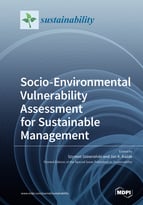Socio-Environmental Vulnerability Assessment for Sustainable Management
A special issue of Sustainability (ISSN 2071-1050). This special issue belongs to the section "Sustainability in Geographic Science".
Deadline for manuscript submissions: closed (31 May 2020) | Viewed by 87464
Special Issue Editors
Interests: spatial analysis; land use planning; sustainable development; city planning; urban sustainability; environmental impact assessment; adaptation to climate change; environmental management; environmental analysis
Special Issues, Collections and Topics in MDPI journals
Interests: sustainable cities and regions; adaptation to climate change; environmental impact assessment; natural resource management; resilience; urban design and planning
Special Issues, Collections and Topics in MDPI journals
Special Issue Information
Dear Colleagues,
The current century seems to be a pivotal point to set the proper trajectory of the human development paradigm. Ongoing parallel processes of urbanization, aging society, population growth, and increasing consumption interplay with threats caused by climate change, extreme weather events, and depletion of resources. As climate-related hazards impact both human and environmental elements, there is a need to explore, analyze, and understand the vulnerability of socioenvironmental systems. Therefore, adaptation to climate change as well as sustainable development require a knowledge-based approach and intelligent solutions for integrated assessment of the state of the environment and society.
This Special Issue would explore cross-disciplinary approaches, methodologies, and applications of socioenvironmental vulnerability assessment that can be incorporated into sustainable management. This Special Issue invites researchers in environment protection and development, urban planning, geography, public policy, and other disciplines and cross-disciplinary fields. Relevant topics include but are not limited to the following areas:
- Environmental carrying capacity and ecological footprint;
- Landscape sensitivity and cultural heritage transformation;
- Environmental impact assessment and human impact assessment;
- Adaptation to climate change;
- Energy poverty and climate justice;
- Aging society and environmental threats;
- Sustainability risk assessment;
- Resilience assessment and mapping;
- Geospatial analyses.
Prof. Szymon Szewrański
Dr. Jan K. Kazak
Guest Editors
Manuscript Submission Information
Manuscripts should be submitted online at www.mdpi.com by registering and logging in to this website. Once you are registered, click here to go to the submission form. Manuscripts can be submitted until the deadline. All submissions that pass pre-check are peer-reviewed. Accepted papers will be published continuously in the journal (as soon as accepted) and will be listed together on the special issue website. Research articles, review articles as well as short communications are invited. For planned papers, a title and short abstract (about 100 words) can be sent to the Editorial Office for announcement on this website.
Submitted manuscripts should not have been published previously, nor be under consideration for publication elsewhere (except conference proceedings papers). All manuscripts are thoroughly refereed through a single-blind peer-review process. A guide for authors and other relevant information for submission of manuscripts is available on the Instructions for Authors page. Sustainability is an international peer-reviewed open access semimonthly journal published by MDPI.
Please visit the Instructions for Authors page before submitting a manuscript. The Article Processing Charge (APC) for publication in this open access journal is 2400 CHF (Swiss Francs). Submitted papers should be well formatted and use good English. Authors may use MDPI's English editing service prior to publication or during author revisions.
Keywords
- Socio-environmental vulnerability
- environmental carrying capacity
- ecological footprint
- environmental impact assessment
- sustainability risk assessment
- resilience assessment







